Electric buses have at last joined Northern Virginia’s largest local bus fleet.
Fairfax Connector launched the eight battery-powered vehicles out of its West Ox Operations and Maintenance Center (4970 Alliance Drive) at 10:30 a.m. last Thursday (Sept. 28), a critical first step forward in the transit system’s plan to phase out diesel or gas-fueled buses.
Supported by four newly installed, 150-kilowatt chargers with two dispensers each, the buses have 39 passenger seats and can travel up to 250 miles on a single charge, according to the Fairfax County Department of Transportation.
“Battery electric buses represent a monumental leap forward in eco-friendly transportation,” FCDOT said in a news release. “These vehicles offer a wide range of environmental benefits, including a drastic reduction in greenhouse gas emissions, a significant reduction in air and noise pollution, and decreased dependence on fossil fuels.”
Another eight electric buses are in the works as part of the new pilot program. Four vehicles currently in production will be delivered to the Huntington Bus Garage, while the other four haven’t started production yet and aren’t slated to arrive until 2025.
The initial eight buses will be deployed on six different routes, covering a wide swath of the county:
- 310: Franconia Road-Rolling Valley
- 395: Gambrill-Pentagon Express
- 901: Herndon Metro-Centreville
- 632: Westfields Blvd-Walney Road
- 463: Maple Avenue-Vienna
- 615: Fair Oaks-Greenbriar
The next eight buses will also be tested “on various routes in the coming months,” FCDOT communications head Freddy Serrano said.
The pilot is launching a little behind schedule. The county had previously hoped to have electric buses on the road by December 2022.
“Additional supply chain impacts caused by the pandemic delayed manufacturing,” Serrano said. “Also, a factory recall was issued and remedied before acceptance of the buses.”
Electric bus recalls sparked by a battery fire this spring also delayed deliveries to Metro, which is expecting 12 vehicles for the first phase of its transition plan and recently landed funds to help convert its Cinder Bed Road Bus Division garage in Franconia into a fully electric facility.
Fairfax County started exploring using electric vehicles for public transportation by piloting an autonomous Relay shuttle in Merrifield until this past June. The Department of Public Works and Environmental Services recently unveiled its first electric trash truck, and Fairfax County Public Schools has added a few electric school buses to its fleet.
While these are Fairfax Connector’s first electric buses, the agency already had several electric support vehicles, including 14 sedans and chargers at its Fair Oaks offices (4050 Legato Road) and two electric vehicles with six chargers at the Herndon Bus Garage (268 Spring Street).
“The pilot program includes several phases and is the first of many steps toward a more sustainable transit system in Fairfax County,” FCDOT transit services division chief and Fairfax Connector head Dwayne Pelfrey said. “Information obtained during the pilot program and on-going evaluation of various technologies will guide strategic decisions in the coming years as we work to build tomorrow’s transit system today.”
Pledging to become carbon-neutral by 2040, Fairfax County adopted an operational energy strategy in 2021 with goals that included halting all diesel bus purchases after this fiscal year — which ends June 30, 2024 — and fully transitioning all buses and fleet vehicles to electricity or a non-carbon-emitting power source by 2035.
Fairfax Connector has more than 300 buses that carry approximately 26,000 riders on 93 routes daily.
Fairfax County has harnessed the fiery power of the sun for two of its fire stations.
The Reston and Woodlawn fire stations are now home to rooftop solar photovoltaic arrays that will generate 17% of the electricity needed for the buildings to operate.
The facilities are the county’s first to get major rooftop solar installations, a milestone that local officials plan to celebrate with a ceremonial flipping of the power switch at the Woodlawn station this Wednesday (Sept. 27).
“Combined, the projects will generate 100 kW of power and provide about 17% of the electricity needed for the two stations,” John Silcox, a spokesperson for the Fairfax County Office of Environmental and Energy Coordination (OEEC), said. “The projects are being managed through an energy performance contract with engineering consulting firm CMTA that will save the county nearly $13,000 in the first year.”
The projects support the county’s operational energy strategy, which aims to ensure that 50% of electricity generated by county facilities comes from renewable energy sources like solar by 2040, among other goals.
The Reston and Woodlawn fire stations were both recently renovated. The approximately $15 million new Reston station at 1820 Wiehle Avenue reopened in the spring of 2022, while the renovation of the Woodlawn station at 8701 Lukens Lane was completed in 2021.
More solar installations will happen at other county facilities this year, Silcox said.
The county has been pursuing a number of solar projects under a power purchase agreement (PPA) initiative announced in 2019, but collapsed lease negotiations with one of the contracted vendors, supply chain issues and rising material costs created complications.
After initially pursuing the Reston Fire Station project and others through the PPA initiative, the county opted instead to hire an energy efficiency firm to install the solar panels in conjunction with other energy upgrades.
Similar projects are in the works at the Sully Community Center, the Spring Hill Rec Center in McLean, the Pender building and the upcoming Springfield commuter parking garage. Another 17 sites are in line for installations next year, county staff told the Board of Supervisors at an environmental committee meeting in July.
OEEC Division Manager for Innovation and Sustainability John Morrill previously told FFXnow that PPA contracts — where the panels are provided by a private company that covers all installation, managment and maintenance costs — are better suited to large-scale projects, like a 40-acre array planned at the I-95 Landfill Complex in Lorton.
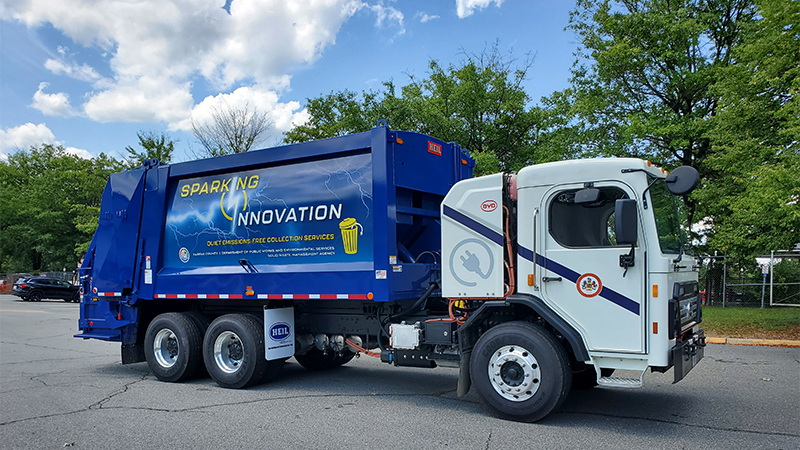
The Fairfax County Department of Public Works and Environmental Services (DPWES) is unveiling its first electric refuse trash truck today (Friday).
The truck will “pick up residential trash and yard waste on routes throughout the county,” DPWES announced. The county says the truck is “a move that will save money and protect the environment.”
The unveiling falls in line with the county’s strategy to make government operations carbon-neutral by 2040.
“Electric vehicles produce zero emissions, meaning cleaner air for Fairfax County. Electric vehicles are quieter, also reducing noise pollution. The electric truck saves residents money by requiring less overall maintenance and eliminating fuel costs,” the site reads.
The truck will join a fleet that already has 50 electric vehicles in operation, including four sedans used by DPWES. In addition, Fairfax County Public Schools has eight electric school buses.
Scott Peterson, vice chair of local environmental advocacy group Faith Alliance for Climate Solutions, called the new trash truck a positive first step.
“We hope the trial is successful and that electric trash trucks in the county, both private and county-owned, will quickly become the new normal,” Peterson said. “Heavy trucks running through our neighborhoods won’t be polluting the air we all breathe, and they’ll be so much quieter, too.”
Charging stations have been installed at the DPWES Newington Collections facility at 6901 Allen Park Road, where the county is holding the unveiling.
“When the battery has less than 20 percent of power, it will take up to five hours to recharge. Once it’s on its route, this truck can hold up to seven tons of recycling and up to 12 tons of trash,” the county says.
The trucks cost the county roughly $350,000 and are paid for by the Department’s Solid Waste Management Program and a Virginia Department of Environmental Quality grant. The county expects to have a second electric truck in September.
The unveiling is open to the public, and several county lawmakers are scheduled to speak. The event starts at 11 am.

Dulles International Airport will soon be able to generate solar energy on its grounds.
Dominion Energy and the Metropolitan Washington Airports Authority will break ground on a new solar energy and storage project — called Solar + Storage Project — on vacant land near airport today (Tuesday).
The venture is the largest solar energy project developed at a U.S. airport, according to MWAA.
Construction is expected to begin later this year, according to Aaron Ruby, a spokesperson with Dominion Energy. The project will wrap up by late 2026.
“This will be the largest renewable energy project ever developed at a U.S. airport. Millions of travelers flying in and out of Dulles each year will see this powerful symbol of the clean energy transition,” Ruby said.
The utility company plans to install the tens of thousands of solar panels and will build and maintain a 2 megawatt solar carports. MWAA will also have access to electric buses, electric vehicles and associated charging infrastructure.
Approved by the Loudoun County Board of Supervisors in January, the project will cover 800 acres of land and is expected to generate enough electricity to power 25,000 homes, according to the Gazette Leader. It will support both the airport and surrounding neighborhoods through Dominion’s grid.
A groundbreaking on the project is set for 11:30 a.m. Sen. Mark Warner, Fairfax County Board of Supervisors Chairman Jeff McKay and other local and state leaders are expected to attend, according to a press release.
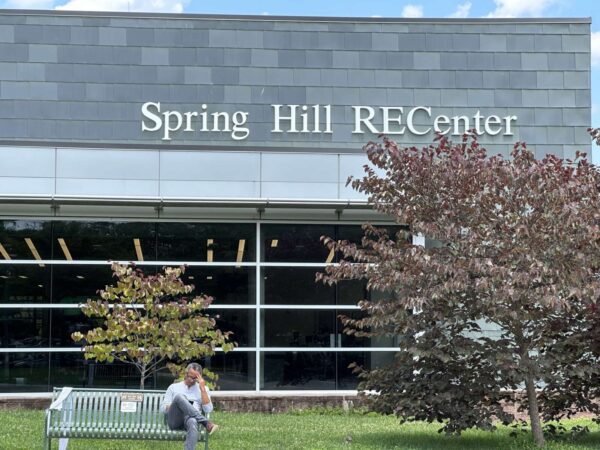
Fairfax County’s efforts to become more energy efficient will get a power boost this week, as work begins on improvements at McLean’s Spring Hill Rec Center.
Set to break ground at 2 p.m. tomorrow (Wednesday), the project will add the recreation center at 1239 Spring Hill Road to a growing list of county facilities supported by solar panels. Other planned changes include pool dehumidification unit replacements, LED lighting upgrades, improved building automation systems and a new geothermal HVAC system.
“The project represents a significant step forward toward meeting the county’s goals for carbon neutrality in its facilities, fleet vehicles and operations, including 50% of county electricity from renewable sources by 2040,” the Fairfax County Park Authority said.
Adopted in July 2021, the county’s Operational Energy Strategy set 2040 as the target date for achieving carbon neutrality in its energy use — the point when it will remove as many greenhouse gas emissions as it releases.
In addition to getting half its electricity from renewable sources by 2040, the county hopes to reach carbon neutrality by cutting overall energy usage in half, transitioning to fully electric or non-carbon-emitting vehicle fleets by 2035 and producing zero waste by 2030, among other goals.
After running into some early roadblocks, particularly when it came to solar panels, the push to make the county’s facilities more energy efficient has picked up steam in recent months.
There are 22 solar projects in progress, including the Spring Hill one as well as five others that are under construction and expected to be completed this year, the Fairfax County Office of Environmental and Energy Coordination reported to the Board of Supervisors at a July 18 committee meeting.
Later this afternoon, the board will hold a public hearing on whether to lease some upcoming facilities, including the new Franconia Governmental Center and planned Mason District Police Station addition, for solar photovoltaic (PV) array installations.
The county has also finished installing 96 electric vehicle charging stations at 11 facilities and has another five locations and 116 charging spaces on the way through 2024, though the Spring Hill Rec Center isn’t on that list.
The rec center will be the county’s fifth energy efficiency retrofit project, following completed upgrades at the Cub Run and South Run rec centers and the City of Fairfax Regional Library. Improvements to the Pender Building that houses the Department of Housing and Community Development are on track to finish this November.
According to the park authority, the Spring Hill Rec Center’s new solar PV array will produce 307 kilowatts of energy, providing 13% of the building’s annual electricity.
“That’s enough energy to power 33 homes, annually,” FCPA spokesperson Benjamin Boxer said.
Coordinated by energy service contractor CMTA, the upgrades are collectively expected to reduce the facility’s electric consumption by 19% and gas consumption by 29% each year, the FCPA says.
The park authority anticipates finishing work on the project by late summer 2024.
“There may be occasional, temporary disruptions to Rec Center operations due to construction activities, but the Park Authority will work to minimize any impacts to our patrons,” Boxer said.
Offering classes, camps and one of the FCPA’s three licensed preschools, the Spring Hill Rec Center hosts a 15,000-square-foot fitness center, an indoor gym, a swimming pool and spa, and various outdoor facilities, including a playground and baseball and soccer fields.
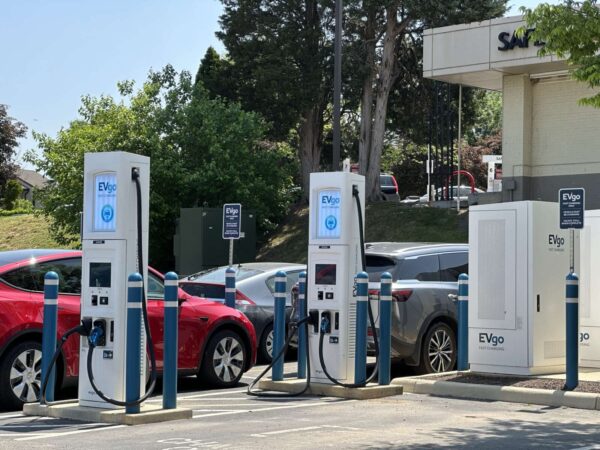
Fairfax County is restarting and opting into a statewide program that helps commercial properties with financing for energy efficiency and resiliency improvements.
Last week, the Fairfax County Board of Supervisors approved the amending and re-adoption of the Commercial Property Assessed Clean Energy and Resiliency (C-PACE) program, which aims to assist commercial building owners with energy and water-saving improvements for little to no upfront costs.
The county first established its own program in 2019, the first in the state to include resiliency projects that address high wind, extreme temperature and flood risks. But in the four years since, no contracts have been executed, and no projects have been completed under the program.
C-PACE is intended as a financial tool designed to “provide long-term private funding to [commercial] building owners for energy-saving and water-saving projects,” according to the county website.
A C-PACE loan is intended to be easier for the property owner to pay off, acting director of the county’s Office of Environmental and Energy Coordination (OEEC) John Morrill told FFXnow in an email.
“The intent of the energy improvements financed through a C-PACE loan is to reduce the operating costs of a property, thereby putting the property owner in a better financial position to pay off all loans,” Morrill said.
He said C-PACE “has struggled to gain traction” because of a confusing process, lack of understanding of the financial product, and the “reluctance” of first-lien debt holders to give up being first to be paid back.
At the meeting, several supervisors expressed their disappointment in the county program so far, voting unanimously to instead opt into a statewide program created in late 2021.
“It’s obviously disappointing that…we adopted a program that has not been used,” Dranesville District Supervisor John Foust said. “I think the step that you are taking us on, with aligning us with the state program, is a very positive change that could help make it more popular.”
Opting into Virginia’s version of C-PACE provides the county with two main benefits, the staff report notes. One, it relieves individual localities from procuring, administrating, and managing contracts.
“Under the statewide program, [the Virginia Department of Energy] is solely responsible for the solicitation of bids, selection of a program administrator, and contract administration,” the report says.
Secondly, it standardizes the program across jurisdictions and provides more support for messaging, engagement, and public awareness. It will also expand the types of projects eligible for loans to include stormwater management and electric vehicle infrastructure.
Morrill said the county hopes partnering with the state will help solve the challenges that the program has faced.
By standardizing application documents in the state program, attorney fees and other transaction costs for completing loans will be less expensive through the state program and result in less friction for getting deals completed. In addition, Fairfax County will work with the state energy office and C-PACE program administrator to promote the availability of C-PACE financing in order to help the market better understand this financial product. As for concern about losing first lien status, we hope consistent marketing and promotion of the program with some success stories will help give lenders confidence that C-PACE can be successful in Virginia, just as it has been in several other states.
But the county had similarly high hopes when it launched C-PACE years ago.
Mason District Supervisor Penny Gross recalled a luncheon in 2018 where the county introduced the program to local business owners. The room was full of excitement that appeared to have nothing to do with the free lunch, she said. But when the program was enacted and the application period opened, the excitement seemingly dissipated.
“I thought we’d sit back and watch the applications roll in, and nothing happened,” Gross said. “It was a great disappointment for those who worked on C-PACE.”
The county hopes local commercial business owners will now become aware of the program and its ability to provide financial help to make climate-friendly changes.
“Now there appears there is a pathway to actually make C-PACE work,” Gross said. “I’m glad the Commonwealth has determined that [the program] really needs the state to come in and assist with this.”
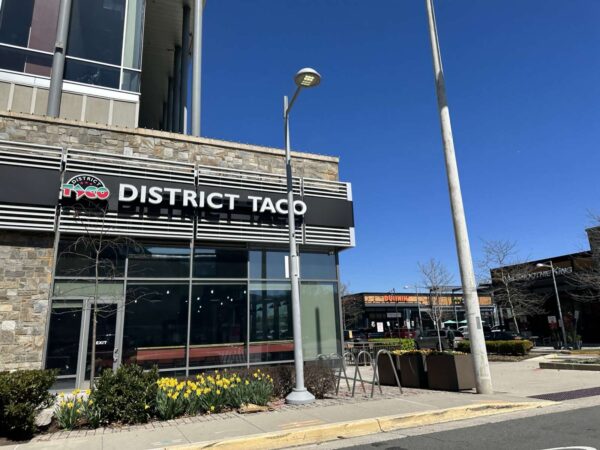
A plan to convert Fairfax County’s streetlights into LED lights is well underway.
At a Board of Supervisors’ safety and security committee meeting on March 22, Aileen Santiago of the county’s Department of Public Works and Environmental Services (DPWES) said the program is expected to generate roughly $1.4 million in yearly savings when completed.
Board Chairman Jeff McKay lauded the conversion program’s work, which he called an investment with a significant return.
“It’s a really good news story in term of the environmental savings standpoint, and it shows the investment we made on the environmental front is paying itself back in a massive way,” McKay said.
The program kicked off in 2018 after the county reached a regional agreement with Dominion Energy to transition into more energy-efficient bulbs.
In Dominion Energy‘s service area — which accounts for 96% of the county’s 60,000 existing streetlights — the conversion process will be completed in fiscal year 2024 using roughly $9 million allocated for five years.
But Northern Virginia Electrical Cooperative (NOVEC) — which is responsible for the remaining 4% of the county’s lights — is largely not accelerating the conversion process for customers in its area, Santiago said.
“Currently, they’re not invested in accelerating and providing reduced rates similar to Dominion,” Santiago told the committee. So far, NOVEC has largely been converting street-facing lights into LEDs, and that inventory is overall limited.
Supervisors expressed disappointment on NOVEC’s progress thus far. Sully District Supervisor Kathy Smith noted that the organization’s service area impacts her constituents significantly.
“It’s not right that NOVEC is not doing the conversions there,” she said.
The conversion program went into effect after the board made amendments to require new and existing streetlights be converted into LEDs with specific color temperatures.
Other board members focused on the need to conduct a more holistic study of lighting needs throughout the county. Currently, the supervisors push streetlight petition requests to county staff.
Referencing a similar board matter passed years ago, Franconia District Supervisor Rodney Lusk stated that the county needs to develop long-term strategies to fund streetlights that are being requested by individuals.
“My concern is that we really don’t have enough focus on what we’re gonna do with regard to the new streetlight requests,” Lusk said.
A programmatic process would require additional funding beyond the county’s current petition program, DPWES Director Chris Herrington said.
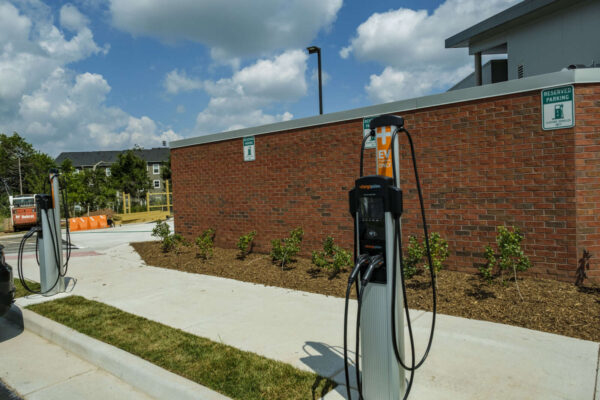
Reston Association is charging up to potentially take part in Fairfax County pilot to get more homeowners’ associations (HOAs) on board with improving access to electric vehicle chargers.
The pilot program, Charge Up Fairfax, would facilitate EV charging by residents in multi-family housing, especially HOAs and condominium associations, by circumventing technical and financial challenges linked to installing stations.
“This program aims to assist HOAs with the installation of publicly available shared charging stations,” said Cameron Adams, RA’s director of covenants administration, in a recent Reston Today video.
The program would also provide support to multi-family communities to install charging stations in common areas. The county would work with HOAs and other groups to install stations in publicly accessible locations that they own.
In the first phase of the program, the county will work with HOAs to identify possible locations and survey the community. This exploration phase will be followed by reviewing by data gathering and community engagement, after which a contractor and equipment will be selected.
Grants would be structured to reimburse communities up to $5,000 for the installation and upkeep of the charging stations. Some communities may be eligible for up to $10,000.
RA expects to hear back from the county on how it can apply to take part in the pilot in the spring, according to Adams. Installation could begin in July — a move that is entirely dependent on funding.
The county’s Office of Environmental and Energy Coordination is seeking $830,000 in grant funding from the U.S. Department of Energy to move forward with the project. The grant application was approved by the Fairfax County Board of Supervisors at a Jan. 24 meeting.
At a Nov. 9 meeting with the county last year, RA members provided feedback on their EV needs and discussed the program. RA’s participation in the program has been proposed since at least late September, when county staff discussed the pilot program with the Fairfax County Board of Supervisors.
The program follows the passage of state legislation that establishes the right of electric vehicle owners to access charging stations. The bill, passed in 2020, bars home and condominium owners from prohibiting the installation of stations under certain conditions.
Still, many challenges remain, including the cost-inhibitive nature of installing and maintaining stations, as well as stringent local regulations on their installation and use.
RA was among the first HOAs in the country to establish design guidelines for electric vehicle charging stations, following a 10-month process in 2021, according to Adams.
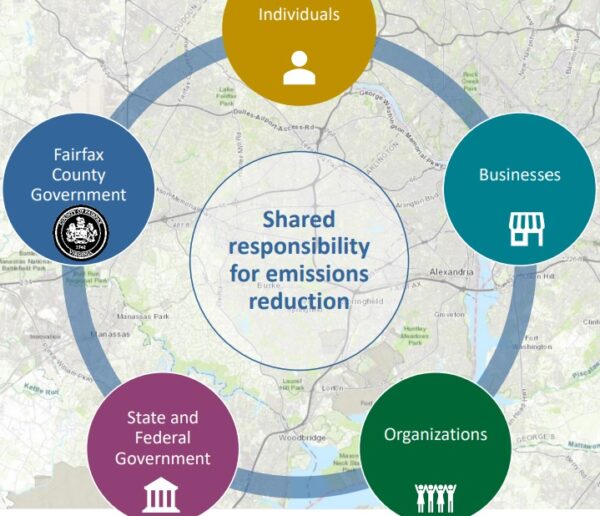
The clock is ticking on Fairfax County’s goal of achieving net-zero new carbon emissions by 2050.
With local government and school operations accounting for just 5% of all emissions, the county is developing a plan to help residents and organizations take action to reduce their carbon footprint and combat climate change.
Presented to the Fairfax County Board of Supervisors at an environmental committee meeting on Dec. 13, the proposal suggests starting to implement the Community-wide Energy and Climate Action Plan (CECAP) adopted in 2021 by partnering with businesses, nonprofits and others that will serve as “climate champions.”
“Every single person and organization can have negative or positive impacts for reducing our greenhouse gas emissions in time to prevent serious harm to our children, nature and communities,” Mount Vernon District Supervisor Dan Storck, chair of the environmental committee, said in a statement. “Each segment of our community…must have simple, easy, adoptable actions to get started and get done the changes we need.”
Expected to roll out early this year, the Climate Champions initiative will take a three-pronged approach, Office of Environmental and Energy Coordination (OEEC) staff told the board:
- A faith-based and nonprofit community pilot, led by the Faith Alliance for Climate Solutions (FACS)
- A business/industry pilot, focused initially on the hospitality sector and led by Visit Fairfax
- An outreach campaign aimed at getting individuals to reduce their greenhouse gas emissions
Having pilot projects focused on specific sectors will help the county tailor its resources, policies and messaging to their needs, Storck said.
A hotel owner, for instance, could provide insight into how their building could be more sustainable — and what incentives would make those changes feasible. Homeowners’ associations could raise awareness of programs like Solarize Fairfax County, which aims to reduce the cost of solar panel installations.
“We can sit in this room all we want, but we need messengers out there in the community, taking ownership of elements in CECAP to make sure we’re successful,” Board of Supervisors Chairman Jeff McKay said at the committee meeting.
Convincing churches and other places of worship to take action on climate change isn’t a challenge for FACS, a nonprofit with over 190 religious groups in Northern Virginia that has been a vocal advocate for CECAP and other environmental measures.
Many faith communities are already tackling climate projects, from solar sanctuaries that would turn them into refuges during power outages to staff at Reston’s St. John Neumann Catholic Church volunteering to clean up for events if they utilize reusable dishes and silverware to reduce waste.
The county’s pilot will help better coordinate those efforts and share ideas, while hopefully encouraging more congregations to get involved, FACS Executive Director Andrea McGimsey told FFXnow. Read More
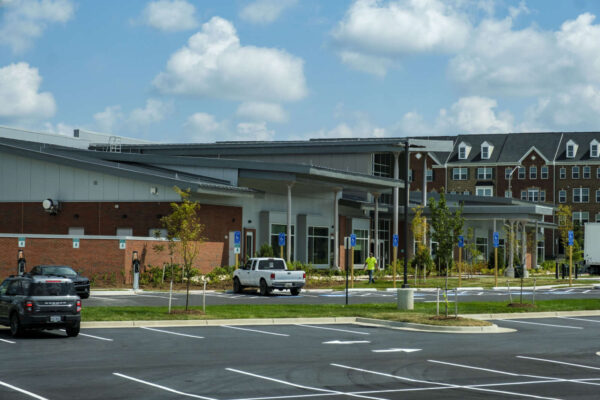
More than three years into a groundbreaking agreement, this spring should bring solar power to one of Fairfax County’s facilities for the first time ever.
The county had 30 sites lined up for solar panels under a power purchase agreement (PPA) initiative that was touted the biggest ever undertaken by a Virginia locality when it was announced in December 2019.
Then, lease negotiations with the company contracted to install and operate the panels stalled, forcing the county to start from scratch with a different provider in July 2021.
“With the pandemic, there were supply chain issues within the solar industry and the cost of some construction materials went up,” said John Morrill, the county Office of Environment and Energy Coordination’s (OEEC) division manager for innovation and sustainability. “The county negotiated and accepted revised pricing from the vendors. But it’s still challenging, and the size of the system is still important to make the numbers work for both parties.”
Though the PPA initiative remains in place, the county is also pursuing other options to outfit its properties for solar power — specifically, incorporating it into new construction projects or enlisting energy services companies to do energy efficiency upgrades.
The solar project expected to be completed first will come from the general contractor hired to build the Sully Community Center, which opened in the Dulles area on Sept. 17.
The contractor is currently getting permits for the solar photovoltaic panels, putting the installation on track for completion by May, according to the Fairfax County Department of Public Works and Environmental Services.
The general contractor route will also ensure that the new Seven Corners Fire Station has solar panels when it opens in spring 2024. The existing station on Sleepy Hollow Road was demolished last month.
Projects are also in various stages of development for the Woodlawn and Reston fire stations, the Spring Hill Recreation Center in McLean, and the Pender building, which hosts the county’s Housing and Community Development offices.
For those sites, the county will buy solar panels from energy services companies hired to install them along with other efficiency upgrades. The fire stations are in the final design phase with delivery target dates in August, while the Spring Hill project is in engineering design and slated for completion in winter 2024.
The county is targeting October for the Pender building upgrades, which are “a bit more complex,” Morrill says. In addition to a rooftop solar array, the project will retrofit the facility’s lighting and replace some other infrastructure, according to a permit under review.
“This combination of approaches gives the county maximum flexibility, as smaller systems…are not suitable to the PPA model,” Morrill said. Read More

